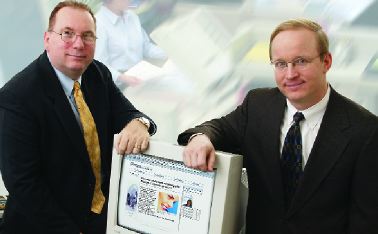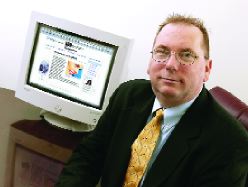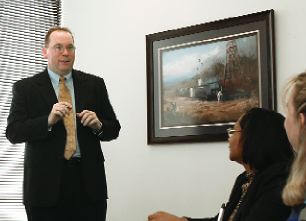
TECHNOLOGY
Advanced Automation, Inc., blends training, networking and common sense to make agencies more efficient, successful
By John Chivvis

Ted Baker (left) founder of Advanced Automation, Inc., helps agencies tame their rush of activity. Scott Kirby of KHT Insurance "leans" on Ted's TEAMS solution to increase revenue per employee.
Ask industry analysts what problems the insurance industry is facing, and issues such as the hard market and interface are mentioned. Ask insurance agents the same question, and they'll add the day-to-day processes of the office to those broader concerns. Ask that same question of Ted Baker, founder and president of the Dallas, Texas-based Advanced Automation, Incorporated, and you'd better be ready for some answers.
Advanced Automation's services and solutions combine technology, peer-to-peer networking, training and plain old common sense to help agencies across the United States build their books of business, reduce overhead, and increase productivity. Clients who, with Baker's help, have taken a fresh look at how they operate describe him as a "professional problem solver," "magician," and even "bulldog."
Addressing the pain
Nancy Sattler, principal owner of Lewiston, Idaho-based Sattler Insurance, explains that her agency's "pain" was trying to get out of the quagmire of paper-based insurance processing. "We were at a point where we had more work than people," says Sattler. The work Sattler refers to is not the selling of insurance but the literal "paper" work that pulls CSRs away from their customer-focused activities.
Scott Kirby, a partner in Fort Worth, Texas-based KHT Insurance, found himself in a similar situation. The "pain" he and KHT faced was making the transition to an electronic environment--an efficient electronic environment. After visiting other agencies to see how they introduced and used scanning, Kirby realized that while everyone says scanning improves processes, going "paperless" can be accomplished in a number of ways, and some approaches are definitely better than others.
Sattler agrees and recalls visiting one agency that was adding steps, rather than subtracting them, as the agency added scanning to the workflow. The agency still maintained a full paper file on each account. In addition, the agency was utilizing transactional filing. So when a paper record arrived, one copy would go in the customer's paper file, and a copy of that same record would go in the T-file. What's more, the agency would input the information into the management system. In that instance, she says, "I didn't see a cost or time benefit to scanning. I saw three times the work."
After Sattler and Kirby heard Baker's presentation on building efficient workflows that incorporate scanning, both enrolled their agencies in the Advanced Automation solution--TEAMS--The Electronic Agency Management System. While not a management system per se like the AMS or Applied Systems used in Sattler's and Kirby's respective agencies, TEAMS integrates training, networking, and accountability.
Information when you need it
In the training area, Baker and company offer more than 20 live classes a month. Topics range from workflow issues, software products, insurance-specific tools, "or anything else our members say they want," according to Baker. Some of the classes are held via teleconference, some are teleconferences with a Web component, and everything is recorded and posted to the TEAMS Training and Learning Center. This way, any of the training materials can be accessed on demand.
For Bill Litjen, COO of the San Diego, California-based G.S. Levine Insurance, the training resources have been invaluable in training new employees. "With the resources available to us from Advanced Automation, we get to hire a whole new level of CSR," says Litjen. "TEAMS enables us to train from the ground up."
The fact that these classes are online and recorded is proof that Baker is serious about reducing the distractions and interruptions of an agency staff. "This allows us to not only save on training, but it allows us to get our entire staff trained without shutting down the office," says Kirby. It has also cut down on the agency's training budget.
As for networking, TEAMS members have access to a powerful knowledgebase that supports and works in conjunction with the Training and Learning Center. Web-based and database driven, the system is threaded and searchable. Members can post and read follow-ups on their own issues. Additionally, they can read up on similar issues that other agencies might have faced and track the discussion from its beginning.
 By streamlining processes and working more efficiently, each CSR "can free up one-and-a-half to three hours a day."
By streamlining processes and working more efficiently, each CSR "can free up one-and-a-half to three hours a day."
--Ted Baker
Besides the online component, Baker and TEAMS provide members with "buddy groups" which put agents of similar management systems together so they can network as well as problem solve. Kirby actually leads one of the buddy groups for Applied Systems users and their group "meets" monthly via teleconference. "Here you have agents talking to agents about the real-world problems they're facing," says Kirby.
"When a member posts a message on an issue to a specific group, we are also notified," says Baker, "and we post it to the knowledgebase." As answers are posted, the system automatically e-mails the answer back to the person. "Plus, they are automatically e-mailed every time the thread is updated."
Litjen notes, "One of the real strengths of the knowledgebase is the quality of the agency members." That is also evident in the Resource Center, an online repository for agents to share what works for them and their agencies. "We've compiled forms, manuals, processes and other materials from agencies, around the Web and world," says Baker. "It's a powerful time-saving tool."
Sattler has found it to be an invaluable resource, in that when she was looking to develop a new procedure, she didn't have to start from scratch. "I found five manuals from other agencies already doing it, so I was able to pick and choose to develop a procedure that works best for our agency."
Membership in TEAMS starts off between $4,000 and $7,000 for the first year, depending on the agency's size, and then drops to an annual renewal fee of $1,500. The membership has more than paid for itself say Kirby, Sattler and Litjen, pointing out that they exceeded the goals set by Baker for TEAMS members.
One of these goals, Baker says, is to "free up one-and-a-half to three hours a day per CSR." Much of this timesaving comes from reducing the interruptions and distractions. "CSRs are interrupted constantly," says Baker, so the question becomes one of control. "Does the day have control over the CSR or does the CSR have control over the day?" he asks.
"Waits" and measures
Efficient workflow implementation of an electronic office is the first step. In the first 90 days of implementing what she and her staff were learning from TEAMS, Sattler wanted to see exactly what was happening and apply some accountability to what was being implemented.
Sattler wanted to know the name of every paper file her CSRs wanted and why. She came away understanding that her CSRs were spending 10 to 15 minutes up to eight times a day actually touching paper files--especially when banks requested a declarations page, for example. As Sattler Insurance began to implement TEAMS-based principles to office workflows and scanning, the need for paper files, and the resulting interruptions declined quickly. "By the end of the first quarter, we were already saving over an hour per CSR," says Sattler.
 Advanced Automation offers more than 20 live classes a month. Topics range from workflow issues, software products, insurance-specific tools, "or anything else our members say they want," Ted says.
Advanced Automation offers more than 20 live classes a month. Topics range from workflow issues, software products, insurance-specific tools, "or anything else our members say they want," Ted says.
Baker reports that one of the most popular courses is "Retraining Customers" and the voice mail greetings of Baker, Sattler, Litjen and Kirby are evidence of its impact. Each person's voice mail greeting includes some variation on "for even faster service, send me e-mail" to his or her e-mail address. "When we give out our phone number, we end up playing voice mail tag for an average of 15 to 30 minutes a day," says Baker. However, by offering and asking for e-mail addresses, Baker says that CSRs can begin to build a more practical habit not only for themselves but also their clients. "We've found that over 50% of those who call and get voice mail will hang up and e-mail," adds Baker.
The time savings that Baker promises don't come in big blocks. Time is saved incrementally, through streamlining processes and working more efficiently. "Ted helps save 15 minutes here and 30 minutes there." says Kirby. "I can tell you for certain, that we're saving at least an hour-and-45-minutes per CSR per day, thanks to Ted."
Another of the goals is to increase the minimum revenue per person in the office to $150,000. "And I don't mean CSRs," says Baker, "I mean the receptionist, the janitor--every warm body in the office." Freeing up CSRs to concentrate on their work is only the beginning because much of what Baker and TEAMS provides is a shift in the mindset of what an insurance agency's role is.
"Too many agencies have bought into the idea that insurance is a service industry," says Baker. "We're so busy with service that we can't protect, and that's why retention is down." To Baker, good service is a customer expectation, no different than the air they breathe. "Customers want to be protected--they want insurance."
Sattler says that her agency fit that description. "We went from being a service agency to a sales agency." When looking at how to motivate sales staff, Sattler wanted to increase cross-selling. Baker suggested that if Sattler tied it to each employee's bonus, she would see a change. "Ted's like a bulldog when he's looking for a solution," says Sattler. "He found an agent in Texas for me to talk to who had been doing the same thing for a couple of years."
Both Sattler and Kirby say that their revenues per person are up over the goal of $150,000. Litjen and G.S. Levine's success from the implementation of TEAMS strategies and workflows has been stunning.
"In 1997, we were at a crossroads," says Litjen. "Productivity was at an all-time low, and we were trying to combat that by hiring other agencies' CSRs--because we thought they must know their stuff." What Litjen ended up with was a number of dissatisfied employees, each with a different way of processing insurance. They finished 1997 with 19 employees and $2.2 million in income.
In 1998, they enlisted the help of Baker and began to implement principles and workflows like those found in TEAMS; and within one year, productivity had increased 25%. G.S. Levine closed out 2002 with 38 employees--four of whom are new trainees--and income over $6 million, making them the fastest growing agency in San Diego.
To round out the product set, Advanced Automation offers a Web-based application called CAROL--Customer Account Rep On Line--which provides a customized way for customers to access an agency over the Web. "Our goal with CAROL is to help agents use the Internet properly by promoting value, increasing retention, and providing opportunities to reduce E&O," says Baker. Besides an easy-to-use interface for agents to make Web site changes on the fly, CAROL also provides agents with their own 24/7 call center for their customers.
Advanced Automation also offers a new Performance Review product designed to help evaluate employee productivity and reduce E&O possibilities in the office. The system helps with E&O audits and ties staff compliance to procedures to their actual performance.
Litjen, Kirby and Sattler all say that working with Baker and Advanced Automation has been one of the best decisions they ever made for their respective agency. "When you start changing processes in agencies, people get scared," says Kirby, "but by the end of the first five days, everyone in the office was telling me that it was the best decision we ever made."
For Baker, though, the success of TEAMS in these agencies and many others is proof that it is not about software or hardware, but what he likes to call "mindware."
"It's all about solving problems in the industry, not just doing business," says Baker. "If at the end of the day, we want to have truly helped our customers, then we need to get back to doing what we do best--providing insurance." *
The author
John Chivvis is a Texas-based writer who specializes in topics of technology implementation. His work has appeared in a number of national and regional publications.
For more information
Advanced Automation, Inc.
Phone: (800) 528-6178
Web site: www.advancedautomationinc.com